This week's film special is about the Italian silent film Il fornaretto di Venezia/The Baker Boy of Venice (Mario Almirante, 1923). This film, starring Amleto Novelli and Alberto Collo, was a raving success in Italy, even if censors suppressed the most macabre scenes. Critics praised it as the more restrained answer to the then outdated epics and diva films.
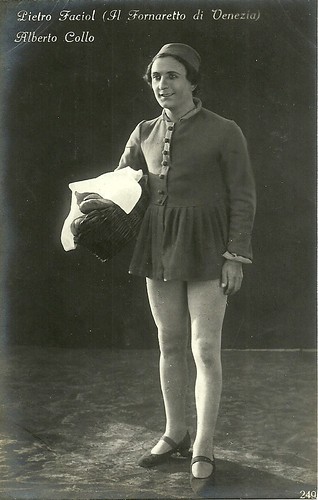
Italian postcard by Ballerini & Fratini, Firenze, no. 249. Photo: publicity still for Il fornaretto di Venezia (Mario Almirante, 1923). Alberto Collo plays the lead role of Pietro Faciol, the baker boy of Venice.
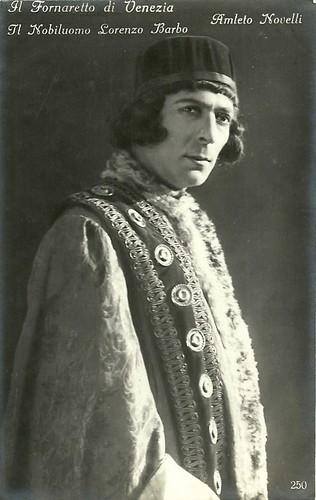
Italian postcard by Ballerini & Fratini, Firenze, no. 250. Photo: publicity still for Il fornaretto di Venezia (Mario Almirante, 1923). Amleto Novelli plays the nobleman Lorenzo Barbo.
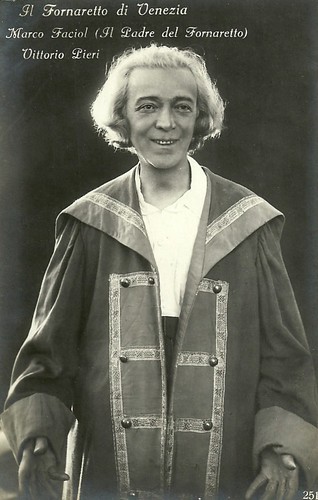
Italian postcard by Ballerini & Fratini, Firenze, no. 251. Photo: Alba Film. Publicity still for Il fornaretto di Venezia (Mario Almirante, 1923). Vittorio Pieri as Marco Faciol, the father of the poor baker boy.
Il fornaretto di Venezia (Mario Almirante, 1923), aka Il povero fornaretto and Il povero fornaretto di Venezia was based on the novel Il Fornaretto (1846) by Francesco Dall'Ongaro. The title translates as The Baker Boy of Venice. Wikipedia also mentions the American TV title The Scapegoat.
The story of the film is situated around 1500, when Pietro Faciol (Alberto Collo), a poor baker boy, is unjustly sentenced to death by the Venetian Council of Ten. The boy is suspected of murder in a trial that becomes a struggle between aristocracy and the people.
The defender in court is Lorenzo Barbo (Amleto Novelli), who finds out the real culprit is a notorious womanizing count who killed the victim with the help of Barbo's wife Clemenza (Niní Dinelli).
The aristocratic court refuses to acknowledge Lorenzo's findings. Lorenzo is finally willing to accuse himself as being responsible. It is too late: the boy has been tortured and executed.
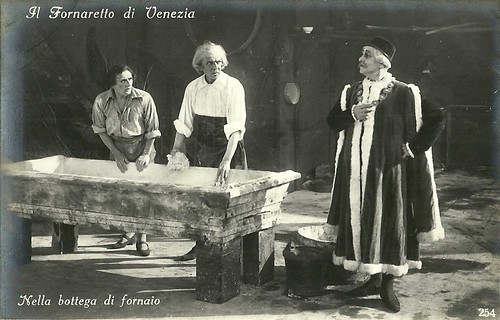
Italian postcard by G.B. Salci, Milano, no. 254. Photo: publicity still for Il fornaretto di Venezia (Mario Almirante, 1923). The caption translates: "In the bakery".

Italian postcard by Ballerini & Fratini, Firenze, no. 255. Photo: Alberto Collo and in Il fornaretto di Venezia (Mario Almirante, 1923). The caption translates: "The baker boy and Annella (Lia Miari), maid of the nobleman Barbo, love each other."
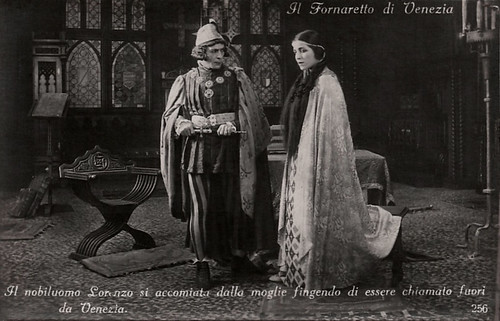
Italian postcard by Ballerini & Fratini, Firenze, no. 256. Photo: Amleto Novelli and Nini Dinelli in Il fornaretto di Venezia (Mario Almirante, 1923). The caption translates: "The nobleman Lorenzo says farewell to his wife, pretending he is called outside of Venice."
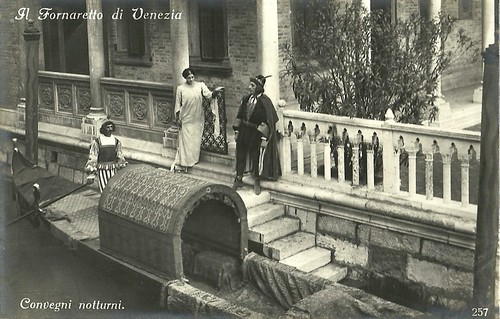
Italian postcard by Ballerini & Fratini, Firenze, no. 257. Photo: publicity still for Il fornaretto di Venezia (Mario Almirante, 1923). Caption: "Nightly gatherings."
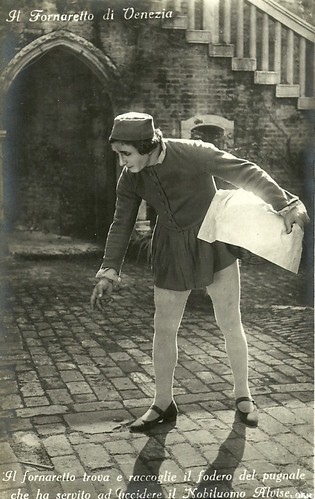
Italian postcard by Ballerini & Fratini, Firenze, no. 258. Photo: Alba Film. Publicity still for Il fornaretto di Venezia (Mario Almirante, 1923). Caption: The baker boy finds and keeps the scabbard of the dagger which served to kill the nobleman Alvise.

Italian postcard by Ballerini & Fratini, Firenze, no. 259. Photo: publicity still for Il fornaretto di Venezia (Mario Almirante, 1923). Caption: "Early meeting of the two bethrothed."
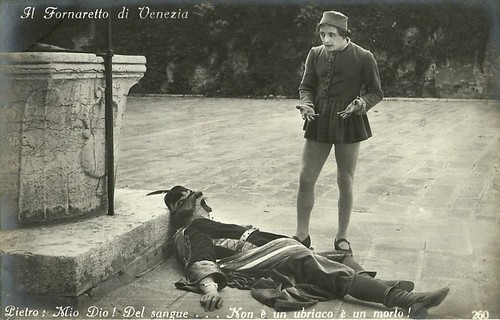
Italian postcard by Ballerini & Fratini, Firenze, no. 260. Photo: publicity still for Il fornaretto di Venezia (Mario Almirante, 1923). Caption: "My God! Blood... He is not drunk but dead!"
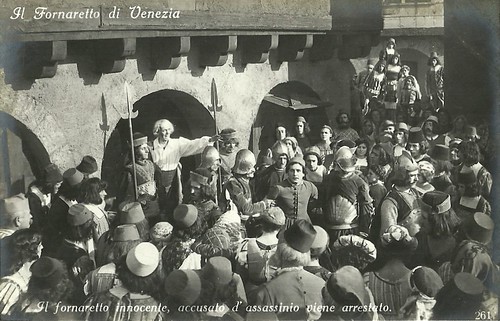
Italian postcard by Ballerini & Fratini, Firenze, no. 261. Photo: publicity still for Il fornaretto di Venezia (Mario Almirante, 1923). Caption: "Though innocent, the baker boy is accused of murder and arrested."
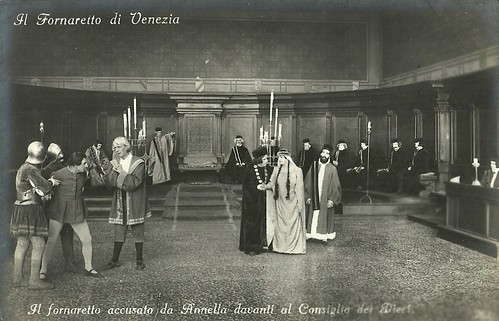
Italian postcard by Ballerini & Fratini, Firenze, no. 262. Photo: publicity still for Il fornaretto di Venezia (Mario Almirante, 1923). Caption: "The baker boy accused by Annella before the Council of Ten."
Il fornaretto di Venezia was a raving success in Italy, even if censors suppressed the most macabre scenes. Critics praised it as the more restrained answer to the outdated epics and diva films.
Both the leading actors Amleto Novelli and Alberto Collo were lauded - although by 1923 Collo was no boy at all anymore. There was also praise for the Venetian scenery. The film continued to be screened in Italy until the end of the silent era.
A year after Il fornaretto di Venezia conquered the cinemas. Amleto Novelli suddenly died. It happened during the shooting of the film La casa dei pulcini in Turin (1924). Novelli was only 38. Post mortem two more historical films with him were released: La congiura di San Marco (1924) and Marco Visconti (1925). He had played in over a 100 Italian silent films.
Il Fornaretto di Venezia was filmed several times. The first film adaptation dates from 1907 and was directed by Mario Caserini. Seven years later, a second silent version followed, directed by Luigi Maggi. In 1939, there was a sound version, Il fornaretto di Venezia/The Fornaretto of Venice (Duilio Coletti, 1939) starring Roberto Villa, Elsa De Giorgi and Clara Calamai. It was made at the Cinecittà studios in Rome.
In 1963, Duccio Tessari directed a colour version, Il fornaretto di Venezia/The Scapegoat (1963). Jacques Perrin played the title role, and his co-stars were Michèle Morgan, Sylva Koscina and Stefania Sandrelli. Duccio Tessari co-wrote the screenplay with Marcello Fondato, based of course on the novel by Francesco Dall'Ongaro.
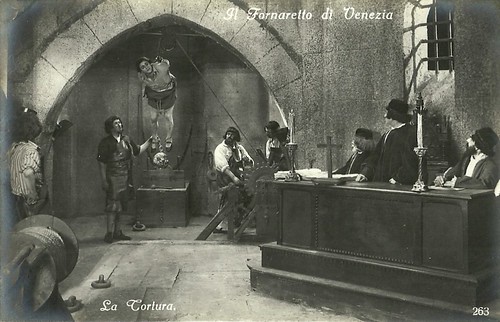
Italian postcard by Ballerini & Fratini, Firenze, no. 263. Photo: publicity still for Il fornaretto di Venezia (Mario Almirante, 1923). Caption: "The torture."
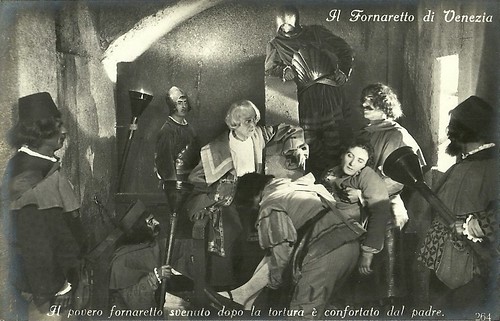
Italian postcard by Ballerini & Fratini, Firenze, no. 264. Photo: publicity still for Il fornaretto di Venezia (Mario Almirante, 1923). Caption: "The poor baker boy, passed out after his torture, is comforted by his father."
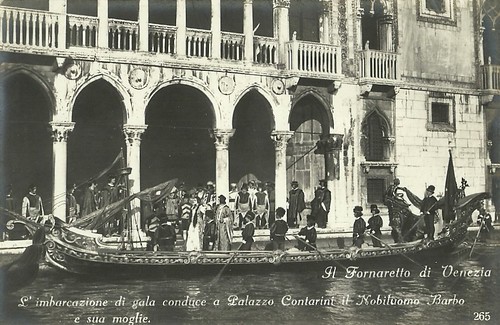
Italian postcard by Ballerini & Fratini, Firenze, no. 265. Photo: publicity still for Il fornaretto di Venezia (Mario Almirante, 1923). Caption: "The gala embarkation leads nobleman Barbo and his wife to Palazzo Contarini."
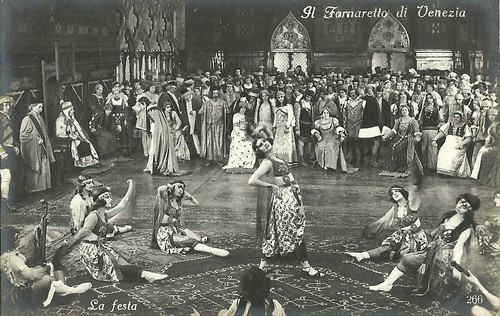
Italian postcard by Ballerini & Fratini, Firenze, no. 266. Photo: publicity still for Il fornaretto di Venezia (Mario Almirante, 1923). Caption: "The feast."
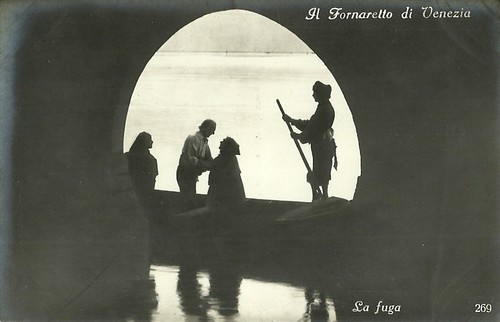
Italian postcard by Ballerini & Fratini, Firenze, no. 269. Photo: publicity still for Il fornaretto di Venezia (Mario Almirante, 1923). Caption: "The flight".
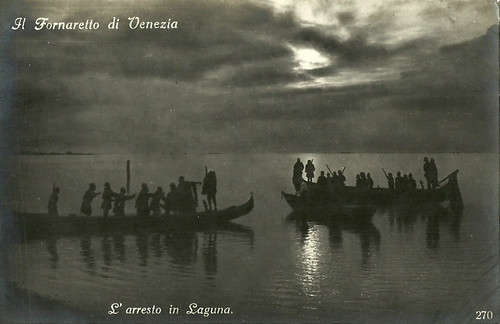
Italian postcard by Ballerini & Fratini, Firenze, no. 270. Photo: publicity still for Il fornaretto di Venezia (Mario Almirante, 1923). Caption: The arrest in the laguna.

Italian postcard by Ballerini & Fratini, Firenze, no. 271. Photo: publicity still for Il fornaretto di Venezia (Mario Almirante, 1923). Caption: "The baker boy is returned to the Palace and led to the scaffold in the Piazzetta."

Italian postcard by Ballerini & Fratini, Firenze, no. 272. Photo: publicity still for Il fornaretto di Venezia (Mario Almirante, 1923). Caption: "The baker boy led to the scaffold between the columns of the Piazzetta."
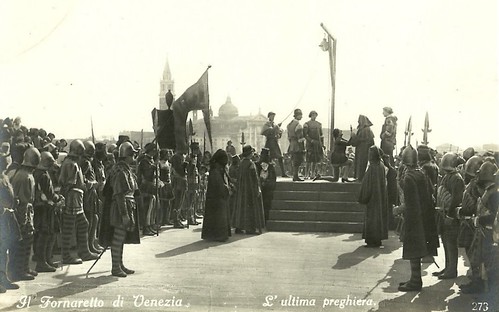
Italian postcard by Ballerini & Fratini, Firenze, no. 273. Photo: publicity still for Il fornaretto di Venezia (Mario Almirante, 1923). Caption: "The last prayer."
Sources: Wikipedia and IMDb.

Italian postcard by Ballerini & Fratini, Firenze, no. 249. Photo: publicity still for Il fornaretto di Venezia (Mario Almirante, 1923). Alberto Collo plays the lead role of Pietro Faciol, the baker boy of Venice.

Italian postcard by Ballerini & Fratini, Firenze, no. 250. Photo: publicity still for Il fornaretto di Venezia (Mario Almirante, 1923). Amleto Novelli plays the nobleman Lorenzo Barbo.

Italian postcard by Ballerini & Fratini, Firenze, no. 251. Photo: Alba Film. Publicity still for Il fornaretto di Venezia (Mario Almirante, 1923). Vittorio Pieri as Marco Faciol, the father of the poor baker boy.
A struggle between aristocracy and the people
Il fornaretto di Venezia (Mario Almirante, 1923), aka Il povero fornaretto and Il povero fornaretto di Venezia was based on the novel Il Fornaretto (1846) by Francesco Dall'Ongaro. The title translates as The Baker Boy of Venice. Wikipedia also mentions the American TV title The Scapegoat.
The story of the film is situated around 1500, when Pietro Faciol (Alberto Collo), a poor baker boy, is unjustly sentenced to death by the Venetian Council of Ten. The boy is suspected of murder in a trial that becomes a struggle between aristocracy and the people.
The defender in court is Lorenzo Barbo (Amleto Novelli), who finds out the real culprit is a notorious womanizing count who killed the victim with the help of Barbo's wife Clemenza (Niní Dinelli).
The aristocratic court refuses to acknowledge Lorenzo's findings. Lorenzo is finally willing to accuse himself as being responsible. It is too late: the boy has been tortured and executed.

Italian postcard by G.B. Salci, Milano, no. 254. Photo: publicity still for Il fornaretto di Venezia (Mario Almirante, 1923). The caption translates: "In the bakery".

Italian postcard by Ballerini & Fratini, Firenze, no. 255. Photo: Alberto Collo and in Il fornaretto di Venezia (Mario Almirante, 1923). The caption translates: "The baker boy and Annella (Lia Miari), maid of the nobleman Barbo, love each other."

Italian postcard by Ballerini & Fratini, Firenze, no. 256. Photo: Amleto Novelli and Nini Dinelli in Il fornaretto di Venezia (Mario Almirante, 1923). The caption translates: "The nobleman Lorenzo says farewell to his wife, pretending he is called outside of Venice."

Italian postcard by Ballerini & Fratini, Firenze, no. 257. Photo: publicity still for Il fornaretto di Venezia (Mario Almirante, 1923). Caption: "Nightly gatherings."

Italian postcard by Ballerini & Fratini, Firenze, no. 258. Photo: Alba Film. Publicity still for Il fornaretto di Venezia (Mario Almirante, 1923). Caption: The baker boy finds and keeps the scabbard of the dagger which served to kill the nobleman Alvise.

Italian postcard by Ballerini & Fratini, Firenze, no. 259. Photo: publicity still for Il fornaretto di Venezia (Mario Almirante, 1923). Caption: "Early meeting of the two bethrothed."

Italian postcard by Ballerini & Fratini, Firenze, no. 260. Photo: publicity still for Il fornaretto di Venezia (Mario Almirante, 1923). Caption: "My God! Blood... He is not drunk but dead!"

Italian postcard by Ballerini & Fratini, Firenze, no. 261. Photo: publicity still for Il fornaretto di Venezia (Mario Almirante, 1923). Caption: "Though innocent, the baker boy is accused of murder and arrested."

Italian postcard by Ballerini & Fratini, Firenze, no. 262. Photo: publicity still for Il fornaretto di Venezia (Mario Almirante, 1923). Caption: "The baker boy accused by Annella before the Council of Ten."
A raving success
Il fornaretto di Venezia was a raving success in Italy, even if censors suppressed the most macabre scenes. Critics praised it as the more restrained answer to the outdated epics and diva films.
Both the leading actors Amleto Novelli and Alberto Collo were lauded - although by 1923 Collo was no boy at all anymore. There was also praise for the Venetian scenery. The film continued to be screened in Italy until the end of the silent era.
A year after Il fornaretto di Venezia conquered the cinemas. Amleto Novelli suddenly died. It happened during the shooting of the film La casa dei pulcini in Turin (1924). Novelli was only 38. Post mortem two more historical films with him were released: La congiura di San Marco (1924) and Marco Visconti (1925). He had played in over a 100 Italian silent films.
Il Fornaretto di Venezia was filmed several times. The first film adaptation dates from 1907 and was directed by Mario Caserini. Seven years later, a second silent version followed, directed by Luigi Maggi. In 1939, there was a sound version, Il fornaretto di Venezia/The Fornaretto of Venice (Duilio Coletti, 1939) starring Roberto Villa, Elsa De Giorgi and Clara Calamai. It was made at the Cinecittà studios in Rome.
In 1963, Duccio Tessari directed a colour version, Il fornaretto di Venezia/The Scapegoat (1963). Jacques Perrin played the title role, and his co-stars were Michèle Morgan, Sylva Koscina and Stefania Sandrelli. Duccio Tessari co-wrote the screenplay with Marcello Fondato, based of course on the novel by Francesco Dall'Ongaro.

Italian postcard by Ballerini & Fratini, Firenze, no. 263. Photo: publicity still for Il fornaretto di Venezia (Mario Almirante, 1923). Caption: "The torture."

Italian postcard by Ballerini & Fratini, Firenze, no. 264. Photo: publicity still for Il fornaretto di Venezia (Mario Almirante, 1923). Caption: "The poor baker boy, passed out after his torture, is comforted by his father."

Italian postcard by Ballerini & Fratini, Firenze, no. 265. Photo: publicity still for Il fornaretto di Venezia (Mario Almirante, 1923). Caption: "The gala embarkation leads nobleman Barbo and his wife to Palazzo Contarini."

Italian postcard by Ballerini & Fratini, Firenze, no. 266. Photo: publicity still for Il fornaretto di Venezia (Mario Almirante, 1923). Caption: "The feast."

Italian postcard by Ballerini & Fratini, Firenze, no. 269. Photo: publicity still for Il fornaretto di Venezia (Mario Almirante, 1923). Caption: "The flight".

Italian postcard by Ballerini & Fratini, Firenze, no. 270. Photo: publicity still for Il fornaretto di Venezia (Mario Almirante, 1923). Caption: The arrest in the laguna.

Italian postcard by Ballerini & Fratini, Firenze, no. 271. Photo: publicity still for Il fornaretto di Venezia (Mario Almirante, 1923). Caption: "The baker boy is returned to the Palace and led to the scaffold in the Piazzetta."

Italian postcard by Ballerini & Fratini, Firenze, no. 272. Photo: publicity still for Il fornaretto di Venezia (Mario Almirante, 1923). Caption: "The baker boy led to the scaffold between the columns of the Piazzetta."

Italian postcard by Ballerini & Fratini, Firenze, no. 273. Photo: publicity still for Il fornaretto di Venezia (Mario Almirante, 1923). Caption: "The last prayer."
Sources: Wikipedia and IMDb.
No comments:
Post a Comment